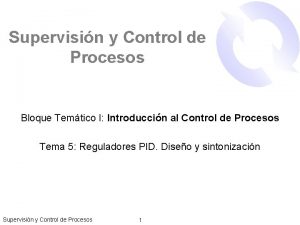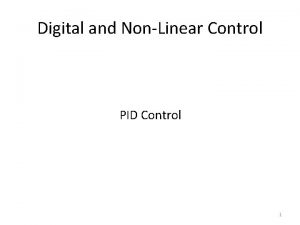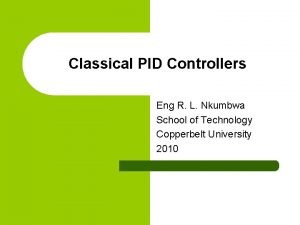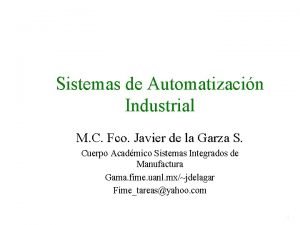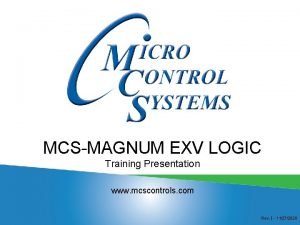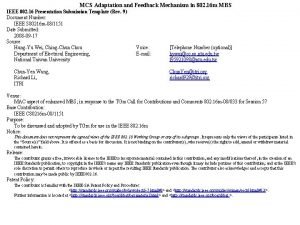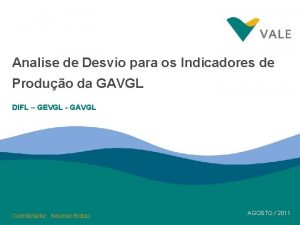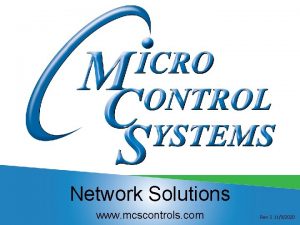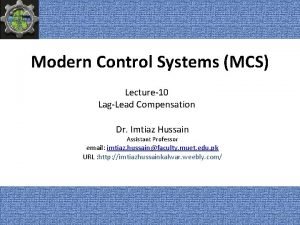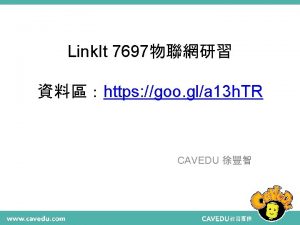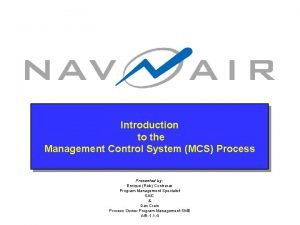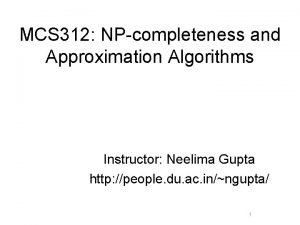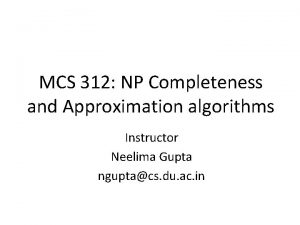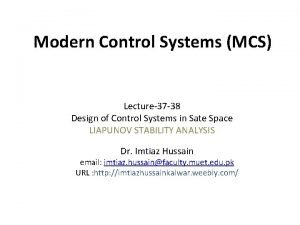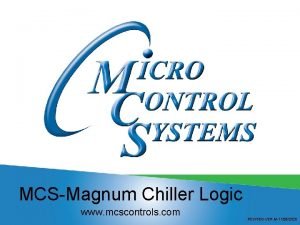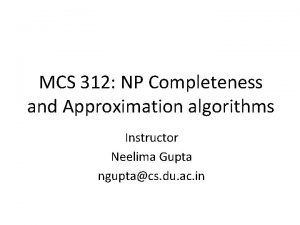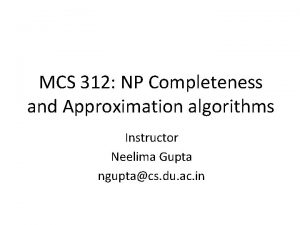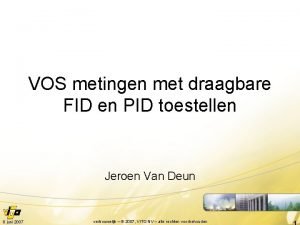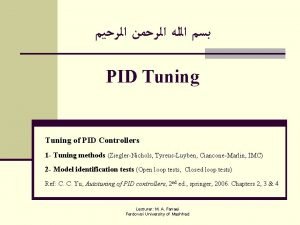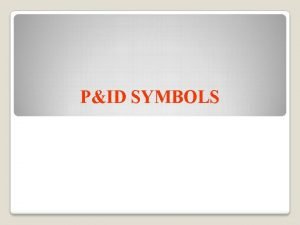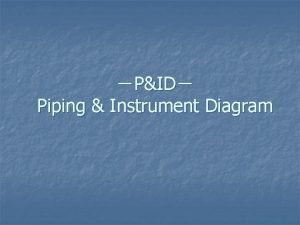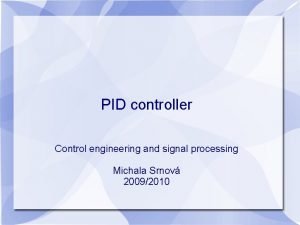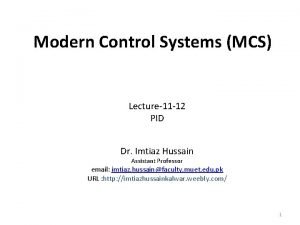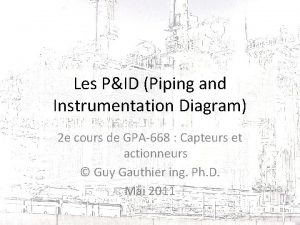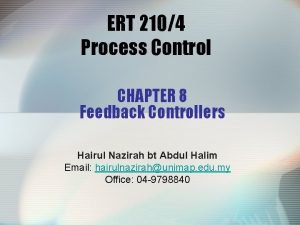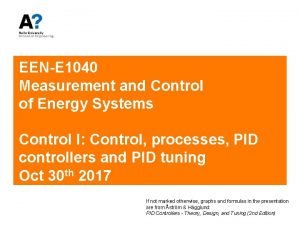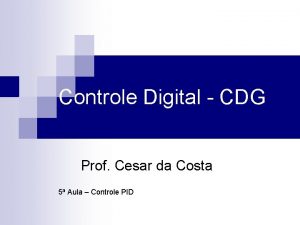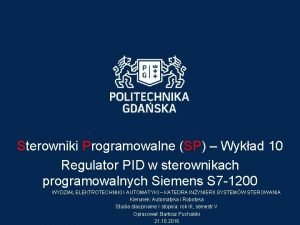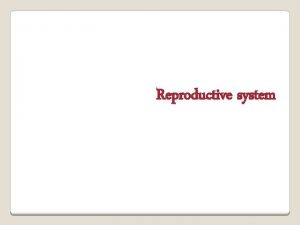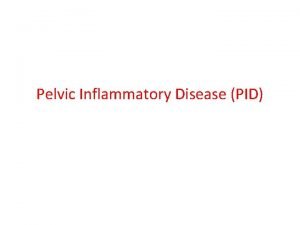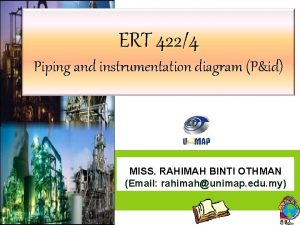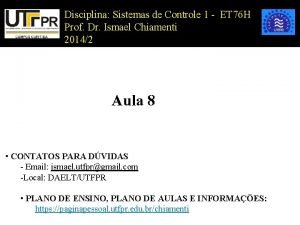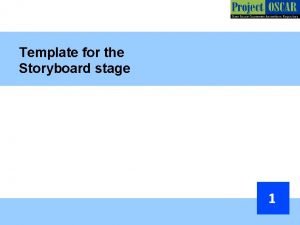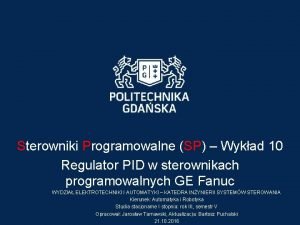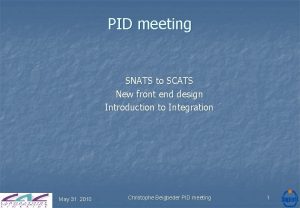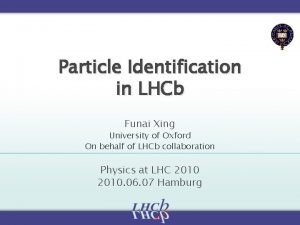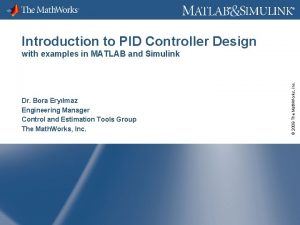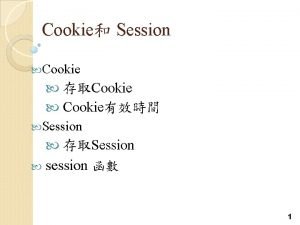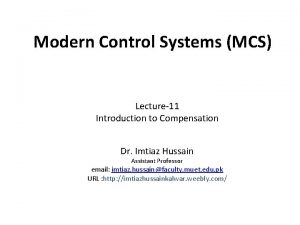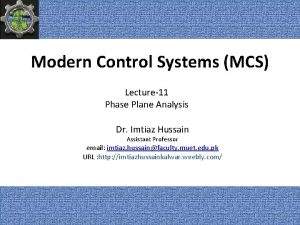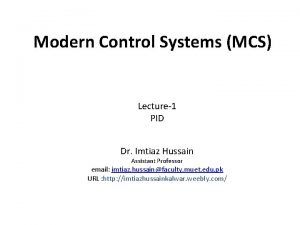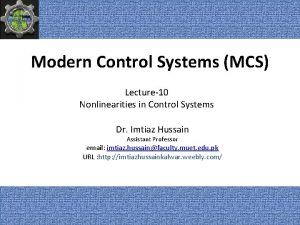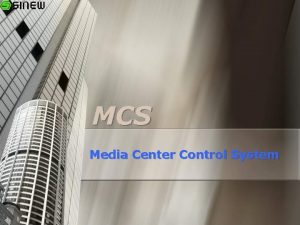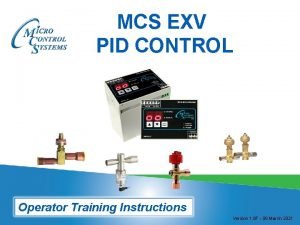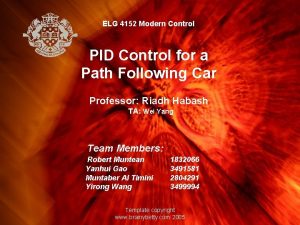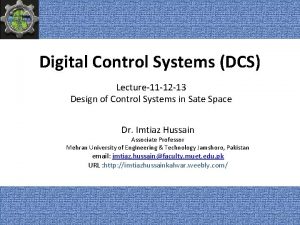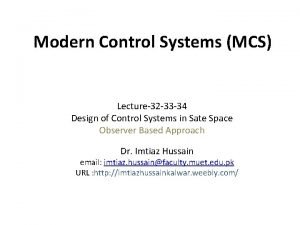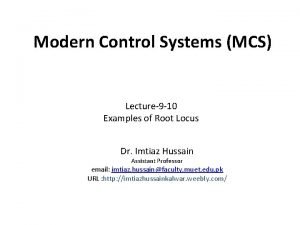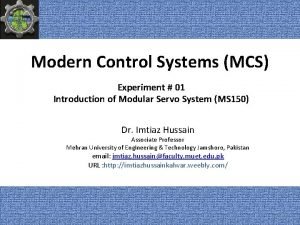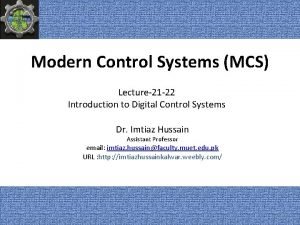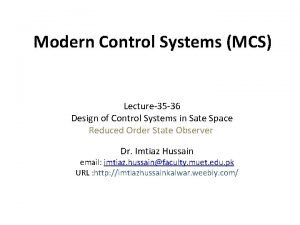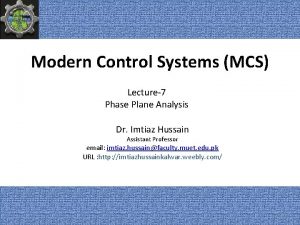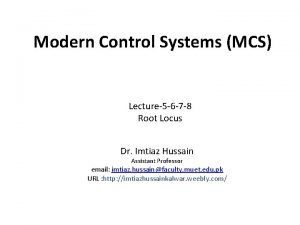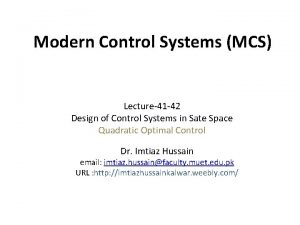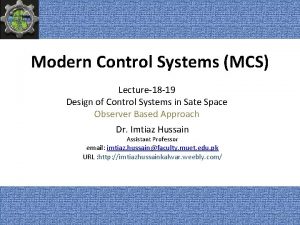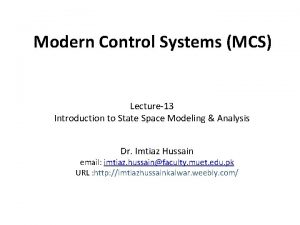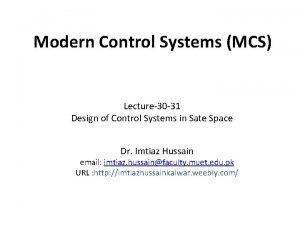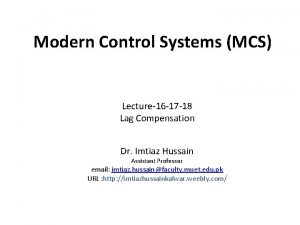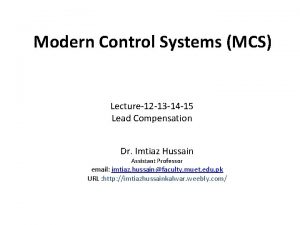Modern Control Systems MCS Lecture11 12 PID Dr














































- Slides: 46

Modern Control Systems (MCS) Lecture-11 -12 PID Dr. Imtiaz Hussain Assistant Professor email: imtiaz. hussain@faculty. muet. edu. pk URL : http: //imtiazhussainkalwar. weebly. com/ 1

Lecture Outline 2

Introduction • PID Stands for – P Proportional – I Integral – D Derivative 3

Introduction • The usefulness of PID controls lies in their general applicability to most control systems. • In particular, when the mathematical model of the plant is not known and therefore analytical design methods cannot be used, PID controls prove to be most useful. • In the field of process control systems, it is well known that the basic and modified PID control schemes have proved their usefulness in providing satisfactory control, although in many given situations they may not provide optimal control. 4

Introduction • It is interesting to note that more than half of the industrial controllers in use today are PID controllers or modified PID controllers. • Because most PID controllers are adjusted on-site, many different types of tuning rules have been proposed in the literature. • Using these tuning rules, delicate and fine tuning of PID controllers can be made on-site. 5

Four Modes of Controllers • Each mode of control has specific advantages and limitations. • On-Off (Bang) Control • Proportional (P) • Proportional plus Integral (PI) • Proportional plus Derivative (PD) • Proportional plus Integral plus Derivative (PID) 6

On-Off Control • This is the simplest form of control. Set point Error Output 7

Proportional Control (P) • In proportional mode, there is a continuous linear relation between value of the controlled variable and position of the final control element. - • Output of proportional controller is • The transfer function can be written as 8

Proportional Controllers (P) • As the gain is increased the system responds faster to changes in set-point but becomes progressively underdamped and eventually unstable. 9

Proportional Plus Integral Controllers (PI) • Integral control describes a controller in which the output rate of change is dependent on the magnitude of the input. • Specifically, a smaller amplitude input causes a slower rate of change of the output. 10

Proportional Plus Integral Controllers (PI) • The major advantage of integral controllers is that they have the unique ability to return the controlled variable back to the exact set point following a disturbance. • Disadvantages of the integral control mode are that it responds relatively slowly to an error signal and that it can initially allow a large deviation at the instant the error is produced. • This can lead to system instability and cyclic operation. For this reason, the integral control mode is not normally used alone, but is combined with another control mode. 11

Proportional Plus Integral Control (PI) + + 12

Proportional Plus Integral Control (PI) • The transfer function can be written as 13

Proportional Plus derivative Control (PD) + + 14

Proportional Plus derivative Control (PD) • The transfer function can be written as 15

Proportional Plus derivative Control (PD) • The stability and overshoot problems that arise when a proportional controller is used at high gain can be mitigated by adding a term proportional to the time-derivative of the error signal. The value of the damping can be adjusted to achieve a critically damped response. 16

Proportional Plus derivative Control (PD) • The higher the error signal rate of change, the sooner the final control element is positioned to the desired value. • The added derivative action reduces initial overshoot of the measured variable, and therefore aids in stabilizing the process sooner. • This control mode is called proportional plus derivative (PD) control because the derivative section responds to the rate of change of the error signal 17

Proportional Plus Integral Plus Derivative Control (PID) + + + 18

Proportional Plus Integral Plus Derivative Control (PID) 19

Proportional Plus Integral Plus Derivative Control (PID) • Although PD control deals neatly with the overshoot and ringing problems associated with proportional control it does not cure the problem with the steady-state error. Fortunately it is possible to eliminate this while using relatively low gain by adding an integral term to the control function which becomes 20

The Characteristics of P, I, and D controllers CL RESPONSE RISE TIME OVERSHOOT SETTLING TIME S-S ERROR Kp Decrease Increase Small Change Decrease Ki Decrease Increase Eliminate Kd Small Change Decrease Small Change 21

Tips for Designing a PID Controller 1. Obtain an open-loop response and determine what needs to be improved 2. Add a proportional control to improve the rise time 3. Add a derivative control to improve the overshoot 4. Add an integral control to eliminate the steady-state error 5. Adjust each of Kp, Ki, and Kd until you obtain a desired overall response. • Lastly, please keep in mind that you do not need to implement all three controllers (proportional, derivative, and integral) into a single system, if not necessary. For example, if a PI controller gives a good enough response (like the above example), then you don't need to implement derivative controller to the system. Keep the controller as simple as possible. 22

Part-II PID TUNING RULES 23

PID Tuning • The transfer function of PID controller is given as • It can be simplified as • Where 24

PID Tuning • 25

PID Tuning • 26

Zeigler-Nichol’s PID Tuning Methods • 27

Zeigler-Nichol’s First Method • In the first method, we obtain experimentally the response of the plant to a unit-step input. • If the plant involves neither integrator(s) nor dominant complexconjugate poles, then such a unit-step response curve may look S-shaped 28

Zeigler-Nichol’s First Method • This method applies if the response to a step input exhibits an S-shaped curve. • Such step-response curves may be generated experimentally or from a dynamic simulation of the plant. Table-1 29

Zeigler-Nichol’s Second Method • 30

Zeigler-Nichol’s Second Method • Thus, the critical gain Kcr and the corresponding period Pcr are determined. Table-2 31

Example-1 1 L t 32

Example-1 33

Example-1 34

Example-2 • 35

Example-2 • Transfer function of the plant is • Since plant has an integrator therefore Ziegler-Nichol’s first method is not applicable. • According to second method proportional gain is varied till sustained oscillations are produced. • That value of Kc is referred as Kcr. 36

Example-2 • 37

Example-2 • 38

Example-2 • 39

Example-2 • 40

Example-2 • Transfer function of PID controller is thus obtained as 41

Example-2 42

Electronic PID Controller 43

Electronic PID Controller 44

Electronic PID Controller • In terms of Kp, Ki, Kd we have 45

To download this lecture visit http: //imtiazhussainkalwar. weebly. com/ END OF LECTURES-11 -12 46
 Multi loop pid controller regolatore pid multi loop
Multi loop pid controller regolatore pid multi loop Control pid
Control pid Control pid
Control pid Classical pid control
Classical pid control “control de grua” and pid
“control de grua” and pid Mcs controls training
Mcs controls training Vad är mcs
Vad är mcs Mcs feedback
Mcs feedback Cisco mcs 7800 end of life
Cisco mcs 7800 end of life Gavgl
Gavgl Mcscontrols
Mcscontrols Haemonetics mcs 8150
Haemonetics mcs 8150 Jpams mcs
Jpams mcs Mcs weebly
Mcs weebly Mcs lite
Mcs lite Mcs process
Mcs process Katherine hubler
Katherine hubler Mcs 312
Mcs 312 Mcs 312
Mcs 312 Mcs weebly
Mcs weebly Mcs magnum controller
Mcs magnum controller Mcs 312
Mcs 312 Mcs 312
Mcs 312 Pid meter werking
Pid meter werking Spike prime motors
Spike prime motors Testastrom
Testastrom Pid controller symbol
Pid controller symbol Pid n
Pid n Pid rise time
Pid rise time Pid persistent identifier
Pid persistent identifier Transfer function of pid controller is
Transfer function of pid controller is Pid schéma
Pid schéma Buzka clicker
Buzka clicker Ert controller
Ert controller Pid rise time
Pid rise time Calculo pid
Calculo pid Pid 3 step
Pid 3 step Premenstrual syndrome discharge
Premenstrual syndrome discharge Pid discharge pictures
Pid discharge pictures P&id hic
P&id hic Erro
Erro Pid controller animation
Pid controller animation Pid isa
Pid isa Pid meeting
Pid meeting Pid xing
Pid xing Bora eryilmaz
Bora eryilmaz Addcart.php?pid=
Addcart.php?pid=

